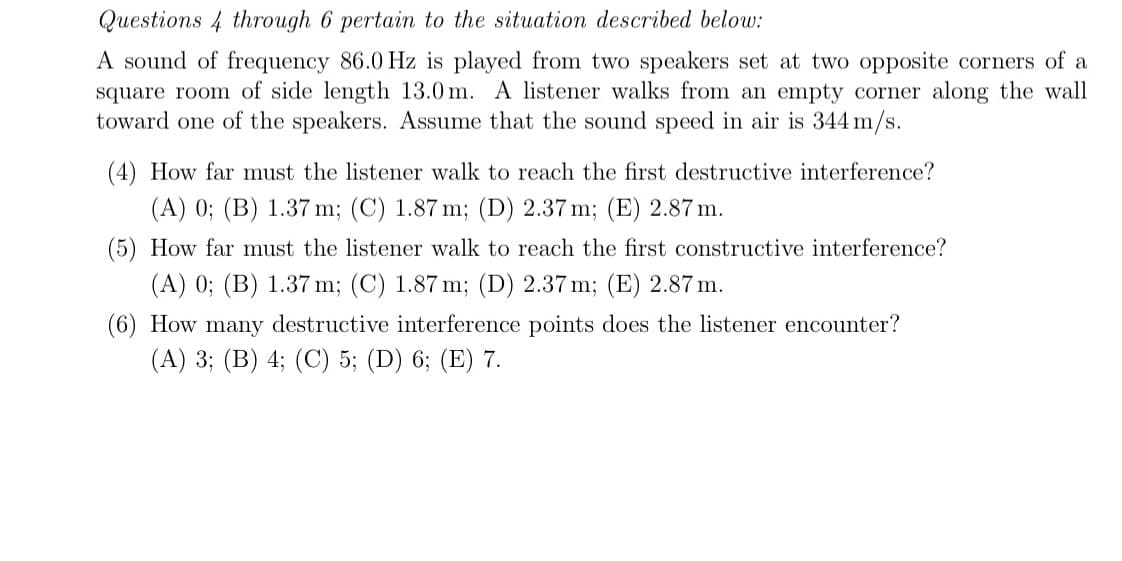A sound of frequency 86.0 Hz is played from two speakers set at two opposite corners of a square room of side length 13.0 m. A listener walks from an empty corner along the wall toward one of the speakers. Assume that the sound speed in air is 344 m/s. (4) How far must the listener walk to reach the first destructive interference? (A) 0; (B) 1.37 m; (C) 1.87 m; (D) 2.37 m; (E) 2.87 m. (5) How far must the listener walk to reach the first constructive interference? (A) 0; (B) 1.37 m; (C) 1.87 m; (D) 2.37 m; (E) 2.87 m. (6) How many destructive interference points does the listener encounter?
A sound of frequency 86.0 Hz is played from two speakers set at two opposite corners of a square room of side length 13.0 m. A listener walks from an empty corner along the wall toward one of the speakers. Assume that the sound speed in air is 344 m/s. (4) How far must the listener walk to reach the first destructive interference? (A) 0; (B) 1.37 m; (C) 1.87 m; (D) 2.37 m; (E) 2.87 m. (5) How far must the listener walk to reach the first constructive interference? (A) 0; (B) 1.37 m; (C) 1.87 m; (D) 2.37 m; (E) 2.87 m. (6) How many destructive interference points does the listener encounter?
University Physics Volume 1
18th Edition
ISBN:9781938168277
Author:William Moebs, Samuel J. Ling, Jeff Sanny
Publisher:William Moebs, Samuel J. Ling, Jeff Sanny
Chapter16: Waves
Section: Chapter Questions
Problem 111P: Two sinusoidal waves with identical wavelengths and amplitudes travel in opposite directions along a...
Related questions
Question
kindly answer all the three subparts

Transcribed Image Text:Questions 4 through 6 pertain to the situation described below:
A sound of frequency 86.0 Hz is played from two speakers set at two opposite corners of a
square room of side length 13.0 m. A listener walks from an empty corner along the wall
toward one of the speakers. Assume that the sound speed in air is 344 m/s.
(4) How far must the listener walk to reach the first destructive interference?
(A) 0; (B) 1.37 m; (C) 1.87 m; (D) 2.37 m; (E) 2.87 m.
(5) How far must the listener walk to reach the first constructive interference?
(A) 0; (B) 1.37 m; (C) 1.87 m; (D) 2.37 m; (E) 2.87 m.
(6) How many destructive interference points does the listener encounter?
(A) 3; (B) 4; (C) 5; (D) 6; (E) 7.
Expert Solution
This question has been solved!
Explore an expertly crafted, step-by-step solution for a thorough understanding of key concepts.
This is a popular solution!
Trending now
This is a popular solution!
Step by step
Solved in 5 steps with 1 images

Knowledge Booster
Learn more about
Need a deep-dive on the concept behind this application? Look no further. Learn more about this topic, physics and related others by exploring similar questions and additional content below.Recommended textbooks for you

University Physics Volume 1
Physics
ISBN:
9781938168277
Author:
William Moebs, Samuel J. Ling, Jeff Sanny
Publisher:
OpenStax - Rice University

Physics for Scientists and Engineers: Foundations…
Physics
ISBN:
9781133939146
Author:
Katz, Debora M.
Publisher:
Cengage Learning

Physics for Scientists and Engineers
Physics
ISBN:
9781337553278
Author:
Raymond A. Serway, John W. Jewett
Publisher:
Cengage Learning

University Physics Volume 1
Physics
ISBN:
9781938168277
Author:
William Moebs, Samuel J. Ling, Jeff Sanny
Publisher:
OpenStax - Rice University

Physics for Scientists and Engineers: Foundations…
Physics
ISBN:
9781133939146
Author:
Katz, Debora M.
Publisher:
Cengage Learning

Physics for Scientists and Engineers
Physics
ISBN:
9781337553278
Author:
Raymond A. Serway, John W. Jewett
Publisher:
Cengage Learning

Physics for Scientists and Engineers with Modern …
Physics
ISBN:
9781337553292
Author:
Raymond A. Serway, John W. Jewett
Publisher:
Cengage Learning

Principles of Physics: A Calculus-Based Text
Physics
ISBN:
9781133104261
Author:
Raymond A. Serway, John W. Jewett
Publisher:
Cengage Learning